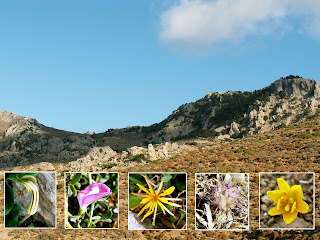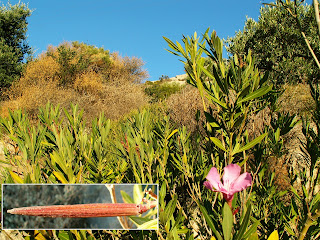That nice little mountain road that we found last
week soon petered out into a dirt track but what the heck, we’ll see more by
cutting across country anyway. Now that autumn is getting underway and there’s
a bit more moisture about a few more flowers are starting to appear. They’re
usually small up here remember so keep your eyes peeled and look in the nooks
and crannies of the rocks.
 |
| Autumn Flowers of the Uplands |
We seem to have a nice little collection: firstly
the shade loving Friar’s Cowl, Arisarum
vulgare; some Spiny Restharrow, Ononis
spinosa,in a damp hollow; a type of Dandelion with inward rolling florets, Taraxacum bithynicum; a stemless Thistle
keeping out of the wind, Carlina
gummifera; and a beautiful little crocus-like flower called Sternbergia greuteriana which is a bit
of a rarity that requires a CITES permit to export so we won’t tell everyone
exactly where we found it or those insidious bulb collectors will be up here
with their trowels.
 |
| The two faces of Euphorbia dimorphocaulon |
Now how did you miss this little beauty? Because it
looks green and boring and hasn’t got any flowers. Not so my friend, this little lady is Euphorbia dimorphocaulon. I know I said
that the little brown job we found last week was called that but they’re the
same plant. He was male. The clue is in the ‘dimorph’ part of the name which means two shapes.
Although most plants are hermaphrodite (both male and female) about six
percent, including this one, are dioecious,
having distinct male and female types. This is just one of the ruses
that plants use to get the most out of their pollinators.
| The robust cerci of the Calliptamus grasshopper |
Take a look at this little fellow a second. When I
first picked him up I thought his rear end was being attacked by a louse or
something. Not an unreasonable supposition seeing as how something has already
had one of his back legs but it is actually a part of the grasshopper called
the cerci, pincer like attachments like those you see on earwigs. This
particular grasshopper belongs to the Calliptamus
genus (either C. italicus or C. barbarus – you have to examine his
penis in minute detail to tell them apart and I think that he’s suffered enough
indignities for one day) and they are noted for their robust cerci. They are
primarily sensory organs although they may be used to assist copulation as
well. I’ll put him back, I expect he’s beginning to wish he hadn’t bothered
getting up this morning.
 |
| Bees, Butterflies and Hornets on Ivy |
I make no apologies for banging on about Ivy again
this week. I mean, just look, have you ever seen such an effusive expanse of
flowers? A couple of weeks back (see Where Mary Sleeps ) I said how useful this plant was at this time of
year to insects and now you can see the evidence with your own eyes. It’s
absolutely buzzing with Honey Bees, Apis
melifera, and Oriental Hornets, Vespa orientalis
and also a goodly number of Painted Lady butterflies, Vanessa cardui, which have been particularly prolific in Crete this
year.
 |
| Church of the Holy Cross with Scorpion |
Well, here we are at the Church of the Holy Cross,
thus dedicated to many churches at high locations in remembrance of the
Universal Elevation of the cross. This is the most sacred symbol of the
Orthodox Church, as it guards the entire universe. Remember to take your headgear
off when you get inside and not before. This is not a religious ritual as such
but in these remote churches you never know who you might dislodge as you open
the door. That Scorpion for instance, Euscorpia
sp. is much better appreciated having bounced off my hat and onto the
floor rather than blundering about in what's left of my hair. The venom in that
stinger may not be fatal but I’m assured that it packs one heck of a punch. We've got a big climb ahead of us next week so if you fancy saying a quick prayer for fortitude now is your chance.
Until next week then.
The Extra Bit
I’m
not usually given to taking selfies but I seem to have photo bombed myself whilst taking this picture of the interior of
the church. If you look at the right hand panel of the Templon (the screen
dividing the sanctuary from the nave) you can clearly see me reflected in the
glass. Does this mean that I am now an icon?
*********************************************************************************
Contrary to popular opinion this
blog is not just thrown together but is actually researched. I’d particularly
like to thank Ralf Jahn at Cretan Flora for species
identification of the flowers this week as well as Josip Skejo and Ammar Azil at The Orthoptera Group for
details regarding the cerci of the Calliptamus
genus of Grasshoppers.
LINKS:
Naturalists
(the facebook page that accompanies this blog)
See detailed pictures at
http://www.inaturalist.org/login (search - people-stevedaniels-observations)







